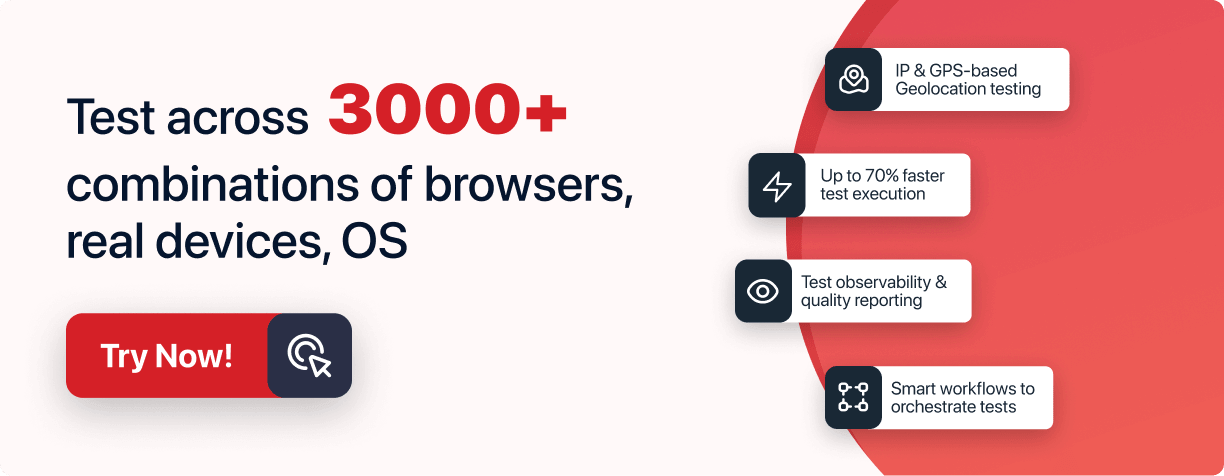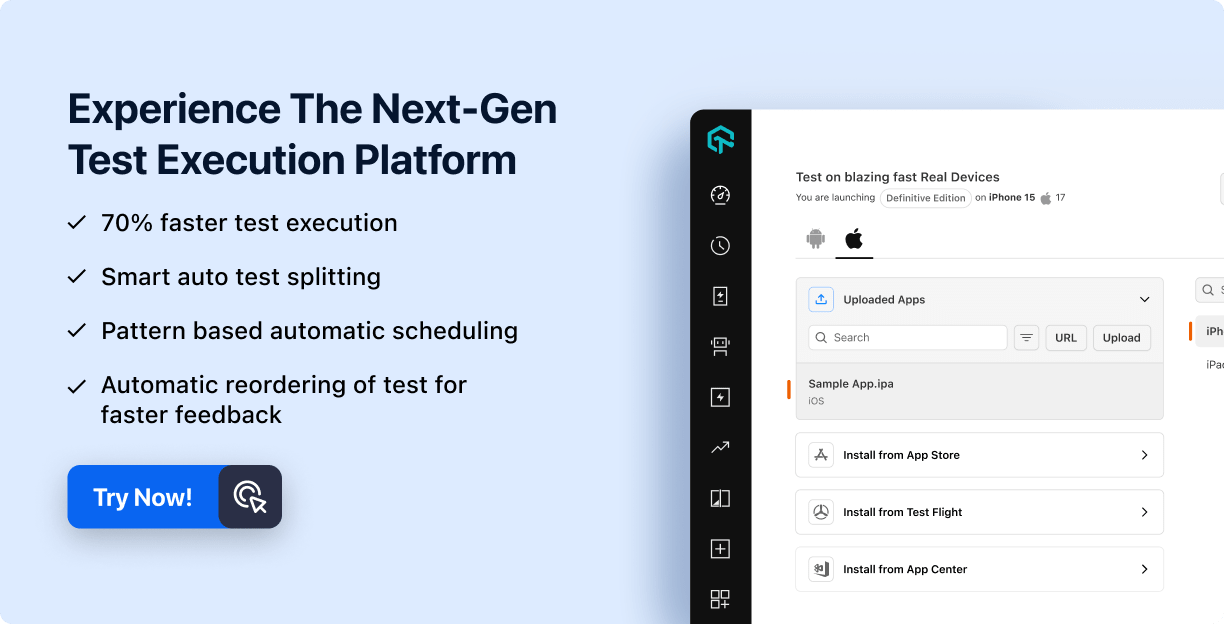Scaling Continuous Testing for Large-Scale Projects
Pricilla Bilavendran
Posted On: July 25, 2024
![]() 79143 Views
79143 Views
![]() 9 Min Read
9 Min Read
We are quite familiar with continuous testing and try to implement it in our projects wherever possible. Also, CI/CD pipeline has been quite a fancy term in recent years. We started noticing this being a part of every job description we see in the market. Iimplementing it is a lot easier for small-scale projects with the diverse tools and frameworks available in the market. How do we deal with it for large-scale projects?
This blog discusses the challenges of implementing CI/CD pipelines for larger projects and some strategies to overcome them.
Benefits of Continuous Testing for Large- Scale Projects
Let’s see some key benefits of performing Continuous testing on your larger scale projects:
- Quicker delivery time to market: By performing continuous testing, the defects are found early in the development phase, which expedites the product’s overall delivery time.
- Increased Test Coverage: By writing automated tests, we can provide better code and test coverage. It helps to test all the paths and reduces the chances of missing potential functional defects.
- Increased Efficiency: By doing continuous testing we can improve the overall quality, resulting in high-quality products that satisfy the customers or consumers.
- Enhanced Collaboration and Communication: The process of continuous testing helps to improve and strengthen communication across teams, which in turn helps in the smooth rollout of the project.
- Increased Confidence in Releases: Continuous testing of the application or product increases trust in each release, which boosts confidence in the overall quality of the application or product.
- Increased agility: By implementing continuous testing the developers can be confident about the recent changes and updates done to the product or the application.
- Ensures Continuous Integration: Through continuous testing, the recent changes are continuously integrated into the main code branch after an extensive testing process.
Challenges of Scaling and Optimizing Continuous Testing for Large-Scale Projects

Maintaining a large-scale project it’s not an easy feat since it requires great effort. Starting from the early phases, it requires multiple hands and dedicated teamwork. Let’s see what are the challenges when we try to implement the process of continuous testing for large-scale projects.
- Managing the Test Environments: Every project has to deal with multiple test environments under prod and pre-prod environments. Based on the project’s nature, the number of environments varies. Some projects keep it simple, some have multiple environments and then they promote the code in waves. Mimicking the large-scale project environments, setting them up, and maintaining them can be a herculean task.
- Maintaining test stability and reliability: As a project’s size and complexity grow, so do the number of tests required for optimal coverage. This can lead to lengthier test execution durations and an increased risk of test failures owing to system or test environment instability.
- Test Data Management: Managing test data that covers all possible scenarios and variations can be complex and time-consuming. Creation and maintenance of the test data could be a tedious task. You can use tools like Unified Test Manager to centrally create and manage test cases, generate test plans, & execute them on LambdaTest while tracking test run status.
- Data Dependencies: Relying on external data sources can affect the speed and quality of the test execution. For large-scale projects, where there may be numerous data dependencies, managing and updating these dependencies can become complicated and time-consuming.
- Test Case Prioritization: For large projects, we have a pile of test cases, and pick the critical ones that require strong project and business knowledge. Optimizing and prioritizing the test suites can be a big challenge.
- Test Execution Time: As the size of the application grows, the time taken to execute tests increases, resulting in longer feedback cycles. This takes more test execution time or execution cycles.
- Scaling Test Infrastructure: As the number of tests increases, the need for a robust and scalable test infrastructure is demanded. This includes hardware resources, virtual machines, and reliable tools for test execution and reporting. Maintaining and scaling this infrastructure to support continuous testing for large-scale projects can be painful. Choose platforms like LambdaTest that offer a scalable test infrastructure with top notch enterprise graded security. Try Now!
- Scaling Automation Suite: For large-scale projects, the creation, updation, and maintenance of automated test cases can be a nightmare. Frequent changes to the code lead to the updation of the automated test cases too.
Strategies for Scaling Continuous Testing
To scale continuous testing for large-scale projects, organizations can adopt the following strategies:
- Selection and Use of Automation Tools: To continually do the right amount of testing between sprints, we need a lot of manpower. Automated testing tools can help here to take a certain load off our shoulders. Pick the right tool and use it wisely can help automate many test cases and improve the overall testing process. Repetitive tasks, time-consuming tasks, stable features, test data creation, and some workflows can be automated to improve overall efficiency. Implementing a robust test automation framework can help in scaling continuous testing.
- Utilize Cloud Testing Platforms: In this cloud era, cloud-based testing platforms such as LambdaTest can help in simulating different environments, browsers, and devices. Hence scaling across multiple platforms becomes easier and less traumatic. Cloud-based virtual machines can be provisioned on-demand, which makes it easier to run tests in parallel.
- Implement Parallel and Distributed Testing: Running multiple tasks parallely can save a certain amount of energy and it helps to provide quick feedback on the quality. For large-scale projects, the time it takes to run tests may become a bottleneck. Leveraging parallel test execution capabilities enables businesses to run tests concurrently, lowering total test execution time and speeding up feedback cycles.
- Think about Containerization: Establishing a process for managing test environments effectively is critical for scaling continuous testing. By using containers, different testing environments can be spun up on demand which enables teams to scale their testing efforts as needed on the go. Containers such as Dockers can be very helpful in managing and deploying the test environments.
- Building efficient CI/CD Pipelines: Continuous integration and continuous delivery (CI/CD) systems like Jenkins, GitLab, and CircleCI can help automate the entire testing cycle. By incorporating testing into the CI/CD pipeline, testing may be initiated automatically with each code change, resulting in faster feedback and more scalability. Use parameters and variables to build reusable efficient pipelines. Organizations should automate the execution of tests at multiple pipeline stages and include feedback methods to send alerts for failing tests.
- Leverage Test Data Management Tools: Developing a comprehensive test data strategy is essential for large-scale projects. Test data Management tools can help in creating, managing, and maintaining the larger test data sets. They help generate realistic test data, also mask the production data to cater to the business needs for testing purposes.
- Involve Developers in Testing: Involving developers in the testing process can assist us in multiple ways. Testing is not a separate phase, it’s an ongoing activity during every sprint. This strategy can increase testing efficiency and scalability.
- Risk-based Testing: Prioritizing testing based on risk allows teams to focus their efforts on the most critical components of the application, lowering total testing time. This also guarantees that any potential concerns with high-risk features are identified and handled at an early stage.
- Continuous Monitoring: Continuous testing needs to be monitored continuously for efficiency. You can also monitor the performance trends of the CI/CD pipelines and derive the metrics to understand the behavior of the application.
- Utilize Analytics and Reporting Tools: Utilizing a test analytics and reporting tool can provide the overall trend about the application’s performance. This helps us to make informed decisions going forward.
Adopting a Shift-Right Approach for Continuous Improvement
As software development practices continue to evolve, the concept of “shift-right” has emerged as a strategic approach to driving continuous improvement. Instead of depending primarily on standard shift-left testing procedures, this methodology focuses on monitoring and optimizing application performance in production.
During the shift-right approach user feedback is gathered, production environments are monitored, and data-driven insights are used to identify and leverage areas for improvement. By shifting the focus to the post-deployment stage, organizations can better understand how their applications are performing in the real world and help with future development and optimization efforts.
Key elements of the shift-right approach include:
- Monitoring in Production: Once moved to production, we need to closely monitor the performance, patterns, user behaviors, and application usage to identify bottlenecks and opportunities for optimization.
- User Feedback: Post-production, collecting the User Feedback and analyzing it can provide insights on the application usage, pain points, usability, and feature requests, which helps us to improve and decide for future developments.
- Test Data Generation: Many modern techniques are available for realistic test data generation. Using those techniques and tools, we can create data that accurately represents the production allowing for more thorough testing and validation.
- Test Environment Simulation: For measuring the performance and robustness we need to replicate the production environment in a controlled testing environment to imitate real-world behavior.
Organizations can foster a culture of continuous improvement by adopting a shift-right approach, which focuses on delivering the proper features and ensuring that those features give the desired user experience and business results. Of course, shift-left is important, but we must focus and find the right balance between “shift-left” and “shift-right”. Adopting the right amount of shift-right helps us to study and assess the application even after moving into production. To know more read: Shift left vs Shift Right Testing.
In a Nutshell
Large-scale projects require a lot of resources, including time, effort, tools, and money. Testing those big-scale projects might require comprehensive test planning and team effort.
To summarize, expanding continuous testing for large-scale projects demands a combination of strategic planning, automation, and communication among teams. Organizations may ensure high-quality software delivery on a large scale by addressing the issues and executing the appropriate strategies. This blog would have helped your testing community negotiate the challenges of continuous testing in large-scale projects.
Got Questions? Drop them on LambdaTest Community. Visit now
















